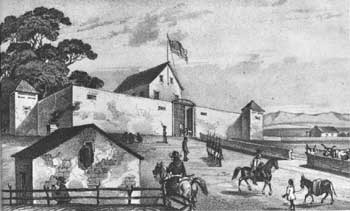






Survey of Historic Sites and Buildings
 |
SUTTER'S FORT California |
 |
| ||
Ownership and Administration. State of California; Division of Beaches and Parks.
Significance. This fort was the headquarters of an agricultural colony, managed by John Augustus Sutter, that figured prominently in the early agricultural development of California, during the period 1840-48. Sutter, a Swiss-German, arrived in the United States in 1834. Four years later he traveled with a caravan of fur traders to Fort Vancouver, and then sailed to the Hawaiian Islands. From there he took passage on a trading vessel and, after visiting the Russian colony at Sitka, Alaska, came to San Francisco in 1839 planning to develop a vast empire in the California wilderness.
In 1840 Sutter became a naturalized Mexican citizen. The following year he obtained from the Mexican Government a provisional grant of 11 square leagues of land (48,818 acres) and purchased Fort Ross and its equipment from the Russians. His herds then totaled 4,500 head of cattle, 1,500 horses, nearly 2,000 sheep, and a large number of hogs. American employees at New Helvetia, as the colony was called, supervised approximately 200 Indians. In 1842 the Indians planted the first crops. By 1845 Sutter controlled ranches, a tannery, gristmill, spinning and weaving shops, a hat factory, a blacksmith shop, a carpenter shop, a shoemaker shop, sawmills, and a salmon saltery.
 |
| Around Sutter's Fort grew the farming colony of New Helvetia, important in the early agricultural development of California. John Augustus Sutter, Swiss-German immigrant who was naturalized a Mexican citizen in 1840, was ruined after the discovery of gold on his property near Coloma. This lithograph is from a sketch made in 1847 by John W. Revere, a U.S. Navy officer. Courtesy, Bancroft Library, University of California. |
For his headquarters and protection from the Indians, during the period 1841-44 Sutter constructed a large quadrangular adobe fort near the confluence of the American and Sacramento Rivers on a knoll overlooking the vicinity. The fort was 330 feet long and varied in width from 120 to 183 feet. Its walls were 2-1/2 feet thick and 18 feet high and had bastions. Within the walls Sutter erected one large building and several smaller ones, including a bakery, mill, and blanket factory.
The Mexican War and the gold rush, touched off by the chance discovery of gold at his sawmill at Coloma, about 40 miles from the fort, brought ruin to Sutter. In October 1848, to avoid foreclosure for debt, he transferred all his property to his oldest son. Late that same year the son surveyed and laid out what was to be the town of Sacramento, about 2 miles from the fort, and soon offered lots for sale. By November 1849 the town had grown to almost 10,000 residents. Forced to sell his fort through his son in 1849 for $40,000 to meet payments on his debts, Sutter moved to Hock Farm, his ranch on the Feather River. There he lived until 1865, when he moved to the East. He died in 1880, still harassed by creditors.
Present Appearance. Sutter's Fort deteriorated until 1890, when the Native Sons of the Golden West purchased it. During the next couple of years the State of California restored it. In 1937 it became a part of the State park system and is now a State historical monument consisting of 6 acres of the original fort site. Exhibits include items of the Reed-Donner emigrant party, pioneer firearms, stagecoaches, mining tools, and furniture and objects associated with Sutter. Numerous exhibits also interpret the story of the fort. [9]
NHL Designation: 01/20/61
 |
 |
http://www.cr.nps.gov/history/online_books/prospector-cowhand-sodbuster/siteb6.htm
Last Updated: 22-May-2005